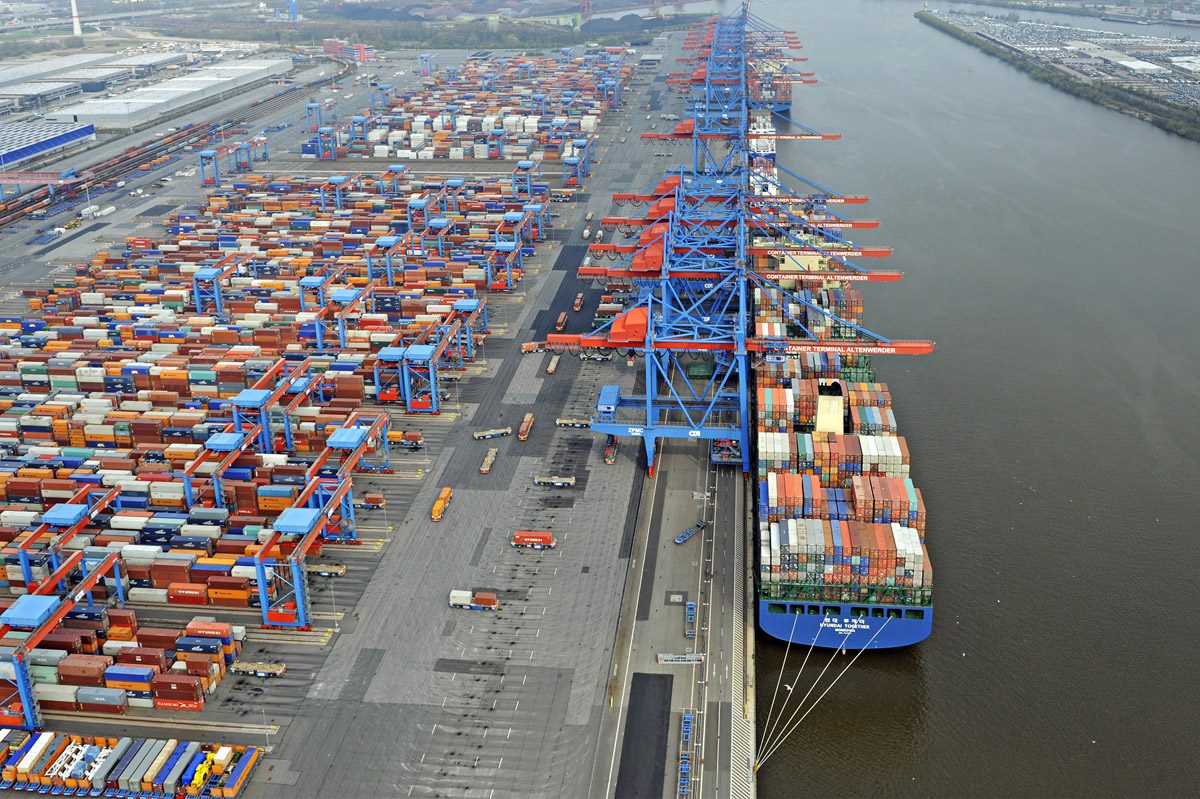HYUNDAI TOGETHER at HHLA Container Terminal Altenwerder, image (c) HHLA
(Bloomberg) — Growth in Hamburg is stalling as Europe’s fiscal crisis spreads into China and other Asian countries, threatening the recovery of Germany’s biggest port.
Hamburger Hafen und Logistik AG, which handles two thirds of containers in Hamburg, cut its forecast for 2012 on July 25, saying it now sees container throughput at the same level as last year, compared with an earlier 5 percent growth estimate. Such an increase would have led to volumes exceeding the record 7.3 million standard containers handled in 2008, the year before the global financial slump prompted a 33 percent drop.
“The port of Hamburg’s Asian exposure is close to 60 percent, and obviously the euro crisis is now having an impact on the Asia-Europe trade line,” said Christian Cohrs, an analyst at M.M. Warburg & Co. KGaA in Hamburg, who has a sell recommendation on shares of Hamburger Hafen, also known as HHLA. “With throughput growth of almost 5 percent in the first quarter and 1.5 percent in the second quarter, the guidance cut assumes nearly a 3 percent decline in volumes in the second half of this year.”
Germany, Europe’s largest economy, is cooling as the euro area, its biggest export market, heads toward recession. Hamburg’s port, on which 275,000 people rely for jobs, largely had been shielded from Europe’s fiscal woes because of expanding trade with China and the Baltic Sea countries. Now these nations are feeling the impact of the debt crisis, and in the three months through June, Hamburg saw its first quarterly drop in container volumes in nine quarters as trade with China slumped.
Falling Shares
HHLA shares have dropped 16 percent in Frankfurt trading so far this year, compared with a 24 percent advance in Germany’s MDAX index, which includes the port operator. HHLA closed up 5.6 percent at 19.22 euros ($23.68) on Aug. 14.
China’s gross domestic product expanded 7.6 percent in the second quarter from a year earlier, the lowest in three years and sixth straight deceleration, as Europe’s debt crisis constrained exports. Industrial-output growth in the world’s second-largest economy unexpectedly slowed to a three-year low of 9.2 percent in July from a year earlier, missing all 32 analysts’ forecasts in a Bloomberg News survey. Export growth collapsed, with outbound shipments up 1 percent last month compared with an 11 percent increase in June.
China is Hamburg’s biggest trading partner, accounting for 33 percent of the 9 million standard boxes it handled in 2011. Russia is No. 2, with 6.6 percent, followed by Singapore at 6 percent and Finland at 3.7 percent. South Korea, the U.S., Sweden, Poland, Malaysia and Brazil are also in the top 10.
Hamburg today reported a 6 percent slump in first-half container trade with Asia to 2.4 million standard boxes and said that “declining demand in Europe, especially, is leaving its mark on container throughput in the China trade” of the German port. Hamburg forecasts container throughput to increase by between 1 and 2 percent in the full year 2012, compared with a 14 percent advance in 2011 and a 13 percent increase in 2010.
Russian Impact
“I am cautious regarding the full year outlook for HHLA,” said Finn Henning Breiter, an analyst at Hauck & Aufhaeuser AG in Hamburg, adding that he estimates container volumes at the port operator will decline 1 percent this year. “Of course Hamburg is affected when exports decrease to Asia, and imports from Asia are decreasing. The question is what Eastern Europe is doing, as Russia has significant impacts” on the port.
Russia expanded 4 percent in the second quarter, the slowest pace in a year, as weakness in China and Europe’s debt crisis curbed demand for its commodities exports. Growth is projected to ease to an annualized 3.2 percent in the third quarter and 3 percent in the last three months of 2012, according to the median estimate in a survey of 12 economists by Bloomberg News between July 19 and July 25.
Still, Hamburg reported a 9.5 percent increase in container trade with the nations around the Baltic Sea, including Russia, to 1 million standard boxes in the first half of this year.
Still Recovering
Hamburg, located by the River Elbe in northern Germany, suffered a 21 percent drop in total seaborne goods, including containers, it handled in 2009. The harbor still hasn’t recovered fully or reached the record 140 million tons for both 2007 and 2008, with volume in 2011 at 132 million tons.
Kuehne + Nagel Group, the biggest sea-freight forwarder, said in its second-quarter earnings report published on July 16 that “muted consumption in all parts of the world” hit the global logistics market in the first half of this year.
“Softened demand affected in particular the trades from Asia to Europe and North America and slowed down volume development in sea-freight and air-freight,” said the Swiss group, which organizes shipments of goods for companies. On Asia-to-Europe trades, Kuehne + Nagel was “affected by the weak market demand, and volumes stagnated,” the company said.
The number of containers handled in the port of Bremerhaven, Hamburg’s German rival, also has been falling in recent months, according to Michael Skiba, marketing chief of Bremenports GmbH & Co. KG, which manages Europe’s No. 4 container harbor.
Partial Blame
“You can blame this, to a certain extent, on the sovereign-debt crisis within the euro zone,” Skiba said. “Exports are slowing.”
HHLA yesterday reported container-volume growth of 3 percent in the first half of this year, the slowest advance for the period since 2009. That compares with a 30 percent expansion in the six months through June in 2011 and a 4.7 percent advance in the first quarter of this year.
That adds to evidence that Germany’s economy is slowing. While exports grew 4.2 percent in May compared with April, they dropped 1.5 percent in June. Industrial production also fell, by 0.9 percent from May, when it gained 1.7 percent, and factory orders declined more than twice as much as economists had forecast, government data showed.
Germany’s gross domestic product growth will slow to 0.5 percent in the third quarter from a year earlier, according to the median estimate of 15 economists in a survey by Bloomberg News between Aug. 3 and Aug. 8. In the three months through June, the economy grew 1 percent from the same period in 2011.
Lowered Forecast
Cohrs lowered his forecast on July 25 for throughput at HHLA this year to 7.17 million 20-foot standard containers, or TEU, which would represent an increase of only 1.1 percent from 2011. The analyst also confirmed Warburg’s sell rating on HHLA, partly because of “a lack of clarity” on its “operational and financial prospects, given Europe’s debt crisis and cost overruns at the modernization of the Burchardkai terminal.”
When HHLA lowered its forecast, the company said it is reviewing the “scalability of capital expenditures” as a result of “the looming economic slowdown” and “unusually high uncertainty” from the European crisis. HHLA now sees earnings before interest and taxes of 170 million euros to 190 million euros, compared with a previous estimate of at least 200 million euros.
“HHLA expected stronger results for the second half, which seemed realistic at the beginning of the year, but now the macro environment has changed,” said Jochen Rothenbacher, an analyst at Equinet AG in Frankfurt.
– Niklas Magnusson and Jan-Henrik Forster, Copyright 2012 Bloomberg

 Join The Club
Join The Club











